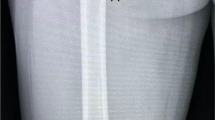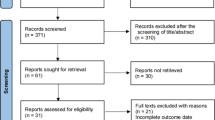Abstract
Background
In high- and middle-income countries, elastic stable intramedullary nailing (ESIN) is the commonest treatment of femur fractures in children 5–11 years of age. At Komfo Anokye Teaching hospital (KATH) in Kumasi, Ghana, prior to this study all pediatric femur fractures were treated with skin traction to union. This study was designed to report the early results and costs of the adoption of ESIN at KATH to provide data to other low- and middle-income sites considering adoption of this surgical technique.
Methods
An observational cohort study that included 84 pediatric patients ages 3–14 years presenting with closed femur fractures and treated with either skin traction or ESIN. Multivariate logistic regression was used to compare the rate of treatment success between treatment groups.
Results
Treatment success (coronal and sagittal angulation less than 10 ° and shortening less than 15 mm at osseous union) was achieved in 92 % of the ESIN group versus 67 % of the skin traction group (odds ratio for ESIN group 9.28 (1.6–54.7); p = 0.0138). Average length of stay was significantly lower in the ESIN group (p = 0.001), but charges to patients were higher in the ESIN group (p < 0.001) because of the high cost of implants.
Conclusions
The initial experience of operative treatment of femoral shaft fractures in children using ESIN was positive, with improved rates of treatment success and no surgical complications. Because of the high cost of implants, direct costs of treatment remained higher with ESIN despite reductions in length of hospital stay.


Similar content being viewed by others
References
Peden MM (2008) World report on child injury prevention. World Health Organization, xvii, Geneva, p 211
Yaffee AQ, Whiteside LK, Oteng RA et al (2012) Bypassing proximal health care facilities for acute care: a survey of patients in a Ghanaian accident and emergency centre. Trop Med Int Health 17:775–781
Rewers A, Hedegaard H, Lezotte D et al (2005) Childhood femur fractures, associated injuries, and sociodemographic risk factors: a population-based study. Pediatrics 115:e543–e552
Grimes CE, Bowman KG, Dodgion CM et al (2011) Systematic review of barriers to surgical care in low-income and middle-income countries. World J Surg 35:941–950. doi:10.1007/s00268-011-1010-1
Hedin H, Borgquist L, Larsson S (2004) A cost analysis of three methods of treating femoral shaft fractures in children. A comparison of traction in hospital, traction in hospital/home and external fixation. Acta Orthop 75:241–248
Gaid M, Jeer P (2006) Cost analysis of managing paediatric femoral shaft fractures: flexible intramedullary nailing versus non-operative management. Acta Orthop Belg 72:170
Clinkscales CM, Peterson HA (1997) Isolated closed diaphyseal fractures of the femur in children: comparison of effectiveness and cost of several treatment methods. Orthopedics 20:1131–1136
Stans AA, Morrissy RT, Renwick SE (1999) Femoral shaft fracture treatment in patients age 6 to 16 years. J Pediatr Orthop 19:222–228
Subasi M, Kapukaya A (2006) Treatment options in pediatric femoral shaft fractures. J Orthop Trauma 20:297 (letter); author reply 297; author reply 298
Flynn JM, Luedtke LM, Ganley TJ et al (2004) Comparison of titanium elastic nails with traction and a spica cast to treat femoral fractures in children. J Bone Jt Surg Am 86-A:770–777
Coyte PC, Bronskill SE, Hirji ZZ et al (1997) Economic evaluation of 2 treatments for pediatric femoral shaft fractures. Clin Orthop Relat Res 336:205–215
Kocher MS, Sink EL, Blasier RD et al (2010) American Academy of Orthopaedic Surgeons clinical practice guideline on treatment of pediatric diaphyseal femur fracture. J Bone Jt Surg Am 92:1790–1792
Wright JG, Wang EE, Owen JL et al (2005) Treatments for paediatric femoral fractures: a randomised trial. Lancet 365:1153–1158
Flynn JM, Schwend RM (2004) Management of pediatric femoral shaft fractures. J Am Acad Orthop Surg 12:347–359
Mani US, Sabatino CT, Sabharwal S et al (2006) Biomechanical comparison of flexible stainless steel and titanium nails with external fixation using a femur fracture model. J Pediatr Orthop 26:182–187
Battle J, Carmichael KD, Morris RP (2006) Biomechanical comparison of flexible intramedullary nailing versus crossed Kirschner wire fixation in a canine model of pediatric forearm fractures. J Pediatr Orthop B 15:370–375
Green JK, Werner FW, Dhawan R et al (2005) A biomechanical study on flexible intramedullary nails used to treat pediatric femoral fractures. J Orthop Res 23:1315–1320
Ho CA, Skaggs DL, Tang CW et al (2006) Use of flexible intramedullary nails in pediatric femur fractures. J Pediatr Orthop 26:497–504
Johnson CW, Carmichael KD, Morris RP et al (2009) Biomechanical study of flexible intramedullary nails. J Pediatr Orthop 29:44–48
Shemshaki HR, Mousavi H, Salehi G et al (2011) Titanium elastic nailing versus hip spica cast in treatment of femoral–shaft fractures in children. J Orthop Traumatol 12:45–48
Flynn JM, Luedtke L, Ganley TJ et al (2002) Titanium elastic nails for pediatric femur fractures: lessons from the learning curve. Am J Orthop (Belle Mead NJ) 31:71–74
Lascombes P, Haumont T, Journeau P (2006) Use and abuse of flexible intramedullary nailing in children and adolescents. J Pediatr Orthop 26:827–834
Buck G (2007) An improved method of treating fractures of the thigh: illustrated by cases and a drawing. 1857. Clin Orthop Relat Res 458:52–58
Li Y, Heyworth BE, Glotzbecker M et al (2013) Comparison of titanium elastic nail and plate fixation of pediatric subtrochanteric femur fractures. J Pediatr Orthop 33:232–238
Flynn JM, Hresko T, Reynolds RA et al (2001) Titanium elastic nails for pediatric femur fractures: a multicenter study of early results with analysis of complications. J Pediatr Orthop 21:4–8
Kasser JR, Beaty JH (2001) Femoral shaft fractures. In: Beaty JH, Kasser JR (eds) Rockwood and Wilkins’ fractures in children. Lippincott Williams and Wilkins, Philadelphia, p 948
Poolman RW, Kocher MS, Bhandari M (2006) Pediatric femoral fractures: a systematic review of 2422 cases. J Orthop Trauma 20:648–654
Buechsenschuetz KE, Mehlman CT, Shaw KJ et al (2002) Femoral shaft fractures in children: traction and casting versus elastic stable intramedullary nailing. J Trauma 53:914–921
Herndon WA, Mahnken RF, Yngve DA et al (1989) Management of femoral shaft fractures in the adolescent. J Pediatr Orthop 9:29–32
Kirby RM, Winquist RA, Hansen STJ (1981) Femoral shaft fractures in adolescents: a comparison between traction plus cast treatment and closed intramedullary nailing. J Pediatr Orthop 1:193–197
Song HR, Oh CW, Shin HD et al (2004) Treatment of femoral shaft fractures in young children: comparison between conservative treatment and retrograde flexible nailing. J Pediatr Orthop B 13:275–280
Sink EL, Gralla J, Repine M (2005) Complications of pediatric femur fractures treated with titanium elastic nails: a comparison of fracture types. J Pediatr Orthop 25:577–580
Bandyopadhyay R, Mukherjee A (2013) Short term complications of titanium elastic nail in the treatment of diaphyseal fracture of the femur in children. Open Orthop J 7:12–17
Hinton RY, Lincoln A, Crockett MM et al (1999) Fractures of the femoral shaft in children. Incidence, mechanisms, and sociodemographic risk factors. J Bone Jt Surg Am 81:500–509
Spiegel DA, Gosselin RA, Coughlin RR et al (2008) The burden of musculoskeletal injury in low and middle-income countries: challenges and opportunities. J Bone Jt Surg Am 90:915–923
Debas HT, Gosselin R, McCord C, et al (2006) Surgery. In Jamison DT, Breman JG, Measham AR, et al (eds) Disease control priorities in developing countries, 2nd edn, p 1245
Wilson NC, Stott NS (2007) Paediatric femoral fractures: factors influencing length of stay and readmission rate. Injury 38:931–936
Ramseier LE, Janicki JA, Weir S et al (2010) Femoral fractures in adolescents: a comparison of four methods of fixation. J Bone Jt Surg Am 92:1122–1129
Rios AU, Arango DF, Molina CO et al (2009) Femoral shaft fractures treated with stainless steel flexible nails in children aged between 5 and 12 years at the HUSVP: a two-year follow-up. J Child Orthop 3:129–135
World Health Organisation (W.H.O.) (2005) Choosing Interventions that are Cost Effective (WHO-CHOICE)
Sturdee SW, Templeton PA, Dahabreh Z et al (2007) Femoral fractures in children; is early interventional treatment beneficial? Injury 38:937–944
Park SS, Noh H, Kam M (2013) Risk factors for overgrowth after flexible intramedullary nailing for fractures of the femoral shaft in children. Bone Jt J 95:254–258
Conflict of interest
All authors declare no external funding or conflicts of interest to disclose.
Author information
Authors and Affiliations
Corresponding author
Rights and permissions
About this article
Cite this article
Kaiser, S.P., Holland, T., Baidoo, P.K. et al. An Observational Cohort Study of the Adoption of Elastic Stable Intramedullary Nailing for the Treatment of Pediatric Femur Fractures in Kumasi, Ghana. World J Surg 38, 2818–2824 (2014). https://doi.org/10.1007/s00268-014-2664-2
Published:
Issue Date:
DOI: https://doi.org/10.1007/s00268-014-2664-2




